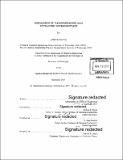Formation of nanoemulsions and entrapped microdroplets
Author(s)
Gupta, Ankur, Ph. D. Massachusetts Institute of Technology
DownloadFull printable version (22.64Mb)
Other Contributors
Massachusetts Institute of Technology. Department of Chemical Engineering.
Advisor
Patrick S. Doyle and T. Alan Hatton.
Terms of use
Metadata
Show full item recordAbstract
Nanoeinulsions (or nano-scale emulsions) are gaining importance in diverse areas like drug delivery, development of smart food drinks, personal care, advanced material synthesis and pharmaceutics. They possess attractive properties such as high surface area, robust stability and tunable rheology. There are two broad categories of method to prepare nanoemulsions: high energy and low energy methods. The literature lacks a mechanistic understanding of nanoemulsion formation leading to a trial and error approach. In this thesis, we address this issue by providing a rationale to synthesize nanoemulsions for both high energy and low energy methods. Specifically, we develop a new scaling theory for high energy methods to control the droplet size of nanoemulsions by taking into account the effect of Ohnesorge number, a parameter that quantifies the internal viscous effects of the droplet. We validate the scaling theory with a wide range of experimental data for different nanoemulsion systems prepared from two high energy techniques. Our experimental results are in good agreement with the predictions and demonstrate the importance of including Ohnesorge number. The proposed relation also compares favorably with the experimental data from literature. We also develop a new droplet breakage frequency model that builds on the scaling theory, and use it in a population balance model to predict the kinetics of droplet size change. The predicted kinetics is consistent with our experimental data as well as data from literature. For low energy methods, we identify that the current understanding in literature in not complete since it not consistent with the existing experimental trends. We propose that migration of surfactant to the interface is the critical step for nanoemulsion synthesis and show that the proposed mechanism works for several model systems. These results thus provide a more general route to synthesize nanoemulsions and open up possibilities that were previously overlooked. Based on our understanding, we exploit low energy methods for use in pharmaceutical formulations and nanoparticle synthesis. Droplets entrapped in a mnicrochannel have potential to serve as a platform for drug discovery, diagnostics, material synthesis and reaction engineering. Current methods in literature require a prior step to generate droplets and do not allow for flexibility in controlling the morphology of droplets. We overcome these limitations by developing a method that uses sequential injection of oil and water over photo-patterned obstacles. By changing the shapes and arrangement of obstacles, we are able to control the morphology of entrapped liquid. We also model the volume of liquid entrapped through geometrical arguments and explain the mechanism of entrapment process. We successfully validate our predictions by experimentally varying the parameters like wetting and shape of the obstacles. We also examine entrapment in patterned side-walls and study the effect of pattern amplitude and frequency.
Description
Thesis: Ph. D., Massachusetts Institute of Technology, Department of Chemical Engineering, 2017. Cataloged from PDF version of thesis. Includes bibliographical references (pages 123-141).
Date issued
2017Department
Massachusetts Institute of Technology. Department of Chemical EngineeringPublisher
Massachusetts Institute of Technology
Keywords
Chemical Engineering.